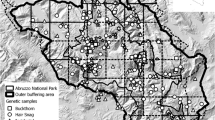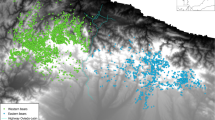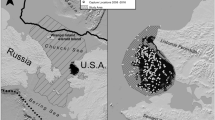Abstract
We present a spatially explicit population model for analysing the expansion of brown bears (Ursus arctos) after the reintroduction program in central Austria. The model is based on field investigations into brown bears in Austria and Slovenia and on current knowledge of brown bears. The landscape of the eastern Alps is represented by a GIS-derived raster map defining local habitat suitability and five major spatial barriers to dispersal. The population model follows the fate of individual bears and simulates reproduction, dispersal, home range establishment, and mortality in annual time steps. We indirectly adjust unknown or uncertain model parameters with 10-year data on the number of females with cubs in central Austria and determine key variables of population dynamics, such as population sizes and growth rates within different population nuclei, dispersal distances, or mortality rates, for model parameterisations that reproduce the data on females with cubs. We estimated a current (1996–2000) growth rate of the population in Austria and adjacent parts of Italy of some 14%; a high proportion of this growth was due toimmigration from Slovenia. Consequently, the growth rate of the subpopulation in central Austria, which probably is isolated functionally (i.e., no exchange of females) from the nuclei along the Austrian–Slovenian border, yielded some 7%. This subpopulation may comprise seven residents, and we estimated for females a 33% risk of extinction during the 1992–2000 period. Validation and confirmation of our model results with data on bear densities that were not used for model construction and parameterisation supported our findings. The high female mortality rates, together with the vulnerability of the small population to chance events (i.e., demographic stochasticity), are the most pressing threat for the population in the eastern Alps. Our approach could be widely applied for analysing dynamics of rare and endangered species in which the paucity of data precludes an appraisal of the state of the population using standard methods.
Similar content being viewed by others
References
Adamic M. 1996. An expanding brown bear population in Slovenia: current management problems. Journal of Wildlife Research 1: 297-300.
Arbeitsgemeinschaft Braunbär Life. 1997. Managementplan für Braunbären in Österreich. Munich Wildlife Society Report, Munich, Germany.
Bjärvall A., Sandegren F. and Wabakken P. 1990. Large home ranges and possible early sexual maturity in Scandinavian bears. International Conference on Bear Research and Management 8: 237-241.
Breitenmoser U. 1998. Large predators in the Alps: the fall and rise of man's competitors. Biological Conservation 83: 279-289.
Burgman M. and Possingham H.P. 2000. Population viability analysis for conservation: the good, the bad and the undescribed. In: Young A.G. and Clarke G.M. (eds), Genetics, Demography and Viability of Fragmented Populations. Cambridge University Press, London, pp. 97-112.
Camarra J.J. 1998. Status and management of the brown bear in France. In: Servheen C., Herrero S. and Peyton B. (eds), Conservation Action Plan for the World Bears. IUCN, Gland, Switzerland, pp. 68-72.
Craighead J.J., Varney J.R. and Craighead F.C. 1974. A population analysis of the Yellowstone grizzly bears. Montana Forest and Conservation Experiment Station, University of Montana, Missoula, Montana.
Delibes M., Gaona P. and Ferreras P. 2001. Effects of an attractive sink leading into maladaptive habitat selection. The American Naturalist 158: 277-285.
Dunning J.B., Stewart D.J., Danielson B.J., Noon B.R., Root T.L., Lamberson R.H. et al. 1995. Spatially explicit population models: current forms and future uses. Ecological Applications 5: 3-11.
Grimm V. 1994. Mathematical models and understanding in ecology. Ecological Modelling 75/76: 641-651.
Grimm V., Frank K., Jeltsch F., Brandl R., Uchmanski J. and Wissel C. 1996. Pattern-oriented modelling in population ecology. The Science of the Total Environment 183: 151-166.
Gutleb B. 1998. The brown bear in Carinthia: history and status in southern Austria. Ursus 10: 75-79.
Kaczensky P. 2000a. Co-existence of brown bears and men in Slovenia. Ph.D. Thesis, Faculty of Forest Sciences, Technical UniversityMunich, Germany. http://tumb1.biblio.tumuenchen.de/publ/diss/ww/2000/kaczensky.html.
Kaczensky P. 2000b. Co-existence of brown bear and man in the cultural landscapes of Slovenia. Report of the Institute of Wildlife Biology and Game Management at the Agricultural University of Vienna, Austria.
Kaczensky P., Knauer F., Huber T., Jonozovic M. and Adamic M. 1996. The Ljubljana-Postojna highway-a deadly barrier for brown bears in Slovenia? Journal of Wildlife Research 1: 263-269.
Kendall B.E., Briggs C.J., Murdoch W.W., Turchin P., Ellner S.P., McCauley E. et al. 1999. Why do populations cycle? A synthesis of statistical and mechanistic modeling approaches. Ecology 80: 1789-1805.
Knauer F. 2000. Ausbreitungsmuster von Braunbären in die Ostalpen. Ph.D. Thesis, Faculty of Forest Sciences, Technical University Munich, Germany. http://tumb1.biblio.tumuenchen.de/publ/diss/ww/2001/knauer.html.
Knight R.R. and Eberhardt L.L. 1985. Population dynamics of Yellowstone grizzly bears. Ecology 66: 323-334.
Mustoni A. and Genovesi P. 2001. Brown bears in the Italian central Alps. International Bear News 10(1): 20.
Pulliam H.R., Dunning J.B. and Liu J. 1992. Population dynamics in complex landscapes: a case study. Ecological Applications 2: 165-177.
Railsback S.F. and Harvey B.C. 2002. Analysis of habitat-selection rules using an individualbased model. Ecology 83: 1817-1830.
Rauer G. and Gutleb B. 1997. Der Braunbaer in Österreich. Monographie 88. Federal Environment Agency, Vienna, Austria.
Rauer G. and Kraus E. 1993. Forschungsbericht Braunbär. 2. WWF Forschungsbericht 10: 1-44.
Rauer G., Aubrecht P., Gutleb B., Kaczensky P., Knauer F., Plutzar C. et al. 2001. Der Braunbär in Österreich II, Vol. M-110. Federal Environment Agency, Vienna, Austria.
Sæther B.-E., Engen S., Swenson J.E., Bakke Ø. and Sandegren F. 1998. Viability of Scandinavian brown bear Ursus arctos populations: the effects of uncertain parameter estimates. Oikos 83: 403-416.
Servheen C., Herrero S. and Peyton B. 1998. Conservation Action Plan for the World Bears. IUCN, Gland, Switzerland.
Swenson J.E., Sandegren F., Bjärvall A., Söderberg A., Wabakken P. and Franzén R. 1994. Size, trend, distribution and conservation of the brown bear (Ursus arctos) population in Sweden. Biological Conservation 70: 9-17.
Swenson J.E., Sandegren F. and Söderberg A. 1998. Geographic expansion of an increasing brown bear population: evidence for presaturation dispersal. Journal of Animal Ecology 67: 819-826.
Swenson J.E., Gerstl N., Dahle B. and Zedrosser A. 2000. Action Plan for the Conservation of the Brown Bear (Ursus arctos) in Europe. Report T-PVS (2000) 24. Council of Europe, Brussels, Belgium.
Taberlet P., Swenson J.E., Sandegren F. and Bjaervall A. 1995. Localization of a contact zone between two highly divergent mitochondrial DNA lineages of the brown bear (Ursus arctos) in Scandinavia. Conservation Biology 9: 1255-1261.
Tufto J., Engen B.-E., Sæther S., Swenson J.E. and Sandegren F. 1999. Harvesting strategies for conserving minimum viable populations based on World Conservation Union criteria: brown bears in Norway. Proceedings of the Royal Society of London, Series B 266: 961-968.
Turner M.G., Arthaud G.J., Engstrom R.T., Hejl S.J., Liu J., Loeb S. et al. 1995. Usefulness of spatially explicit population models in land management. Ecological Applications 5: 12-16.
US Fish and Wildlife Service 1981. Standards for the Development of Habitat Suitability Index Models. US Fish and Wildlife Service, Washington, DC.
US Fish and Wildlife Service 1993. Grizzly Bear Recovery Plan. US Fish and Wildlife Service, Missoula, Montana.
Walters C.J. 1986. Adaptive Management of Renewable Resources. Macmillan, New York.
Walters C.J. 1997. Challenges in adaptive management of riparian and coastal ecosystems. Conservation Ecology 1(2): 1. http://www.consecol.org/vol1/iss2/art1.
Wabakken P., Bjärvall A., Franzén R., Maartmann E., Sandegren F. and Söderberg A. 1992. The Swedish-Norwegian Brown Bear Project 1984-1991. Norwegian Institute for Nature Research, Oppdragsmeling 146 (in Norwegian with English summary).
Wiegand T., Naves J., Stephan T. and Fernandez A. 1998. Assessing the risk of extinction for the brown bear (Ursus arctos) in the Cordillera Cantabrica, Spain. Ecological Monographs 68: 539-571.
Wiegand T., Moloney K.A., Naves J. and Knauer F. 1999. Finding the missing link between landscape structure and population dynamics: a spatially explicit perspective. The American Naturalist 154: 605-627.
Wiegand T., Jeltsch F., Hanski I. and Grimm V. 2003. Using pattern-oriented modeling for revealing hidden information: a key for reconciling ecological theory and application. Oikos 100: 209-222.
Wiegand T., Knauer F. and Revilla E. 2004. Dealing with uncertainty in spatially explicit population models. Biodiversity and Conservation 13: 53-78 (this issue).
Woodroffe R. and Ginsberg J.R. 1998. Edge effects and the extinction of populations inside protected areas. Science 280: 2126-2128.
Zedrosser A., Gerstl N. and Rauer G. 1999. Brown Bears in Austria, Vol. M-117. Federal Environment Agency, Vienna, Austria.
Author information
Authors and Affiliations
Corresponding author
Rights and permissions
About this article
Cite this article
Wiegand, T., Knauer, F., Kaczensky, P. et al. Expansion of Brown Bears (Ursus arctos) into the Eastern Alps: A Spatially Explicit Population Model. Biodiversity and Conservation 13, 79–114 (2004). https://doi.org/10.1023/B:BIOC.0000004314.38828.db
Issue Date:
DOI: https://doi.org/10.1023/B:BIOC.0000004314.38828.db




